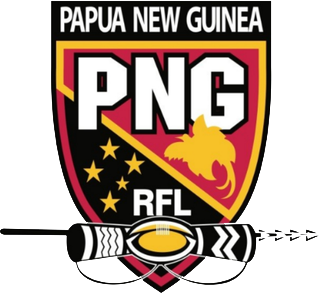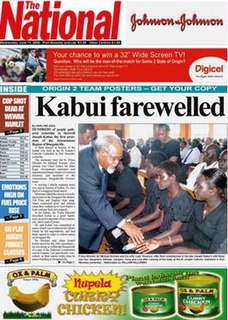
Papua New Guinea, officially the Independent State of Papua New Guinea, is a country in Oceania that comprises the eastern half of the island of New Guinea and its offshore islands in Melanesia. Its capital, located along its southeastern coast, is Port Moresby. The country is the world's third largest island country with an area of 462,840 km2 (178,700 sq mi).
Communications in Papua New Guinea refers to the media in the country which are regulated by the Media Council of Papua New Guinea such as newspapers, radio, television, and the Internet.

The Prime Minister of Papua New Guinea is Papua New Guinea's head of government, consequent on being the leader of the party or coalition with majority support in the National Parliament. The prime minister serves as the head of his party, the head of the coalition government, and the chairman of the National Executive Council. The office of Prime Minister was preceded by the Chief Ministry.

The governor-general of Papua New Guinea is the representative of Papua New Guinean monarch, Queen Elizabeth II, who is known in Tok Pisin as 'Missis Kwin'.

The Territory of Papua comprised the southeastern quarter of the island of New Guinea from 1883 to 1975. In 1883, the Government of Queensland annexed this territory for the British Empire. The United Kingdom Government refused to ratify the annexation but in 1884 a Protectorate was proclaimed over the territory, then called "British New Guinea". There is a certain ambiguity about the exact date on which the entire territory was annexed by the British. The Papua Act 1905 recites that this happened "on or about" 4 September 1888. On 18 March 1902, the Territory was placed under the authority of the Commonwealth of Australia. Resolutions of acceptance were passed by the Commonwealth Parliament, who accepted the territory under the name of Papua.

For administrative purposes, Papua New Guinea is divided into administrative divisions called provinces. There are 22 province-level divisions, which include 20 provinces, the autonomous region of Bougainville and the National Capital District of Port Moresby.

The Papua New Guinea national rugby league team represents Papua New Guinea in the sport of rugby league football.

The indigenous peoples of New Guinea, commonly called Papuans, are Melanesians. There is genetic evidence for two major historical lineages in New Guinea and neighboring islands:
- a first wave from the Malay Archipelago perhaps 50,000 years ago when New Guinea and Australia were a single landmass called Sahul,
- and, much later, a wave of Austronesian people from the north who introduced Austronesian languages and pigs about 3,500 years ago, and who left a small but significant genetic trace in many coastal Papuan peoples.

Mount Wilhelm is the highest mountain in Papua New Guinea at 4,509 metres (14,793 ft). It is part of the Bismarck Range and the peak is the point where three provinces, Chimbu, Jiwaka and Madang, meet. The peak is also known as Enduwa Kombuglu, or Kombugl'o Dimbin, in the local Kuman.

The National Parliament of Papua New Guinea is the unicameral national legislature in Papua New Guinea. It was created in 1964 as the House of Assembly of Papua and New Guinea but gained its current name after the nation was granted independence in 1975.
The Papua New Guinean honours system is the main system of honouring citizens of Papua New Guinea for their services to the country; it consists of three Orders and several medals. After independence, Papua New Guinea used the Imperial honours system, however, in recognition of the nation's 30th anniversary, a new awards system was adopted. The official announcement of its creation was made by Prime Minister Sir Michael Somare on 12 November 2004 and the first investitures were performed by the Princess Royal in early October 2005. The Imperial honours system is still in use as well, however, and the Queen issues a Papua New Guinean List as part of every Birthday and New Year Honours List.

Papua New Guinea has 326 local-level governments (LLGs) comprising 6,112 wards as of 2018.

Papua New Guinea, a sovereign state in Oceania, is the most linguistically diverse country in the world. According to Ethnologue, there are 839 living languages spoken in the country. In 2006, Papua New Guinea Prime Minister Sir Michael Somare stated that "Papua New Guinea has 832 living languages ." Languages with statutory recognition are Tok Pisin, English, Hiri Motu, and Papua New Guinean Sign Language. Tok Pisin, an English-based creole, is the most widely spoken, serving as the country's lingua franca. Papua New Guinean Sign Language became the fourth officially recognised language in May 2015, and is used by the deaf population throughout the country.

This page is a list of districts of Papua New Guinea.
The Papua New Guinea Post-Courier is a newspaper based in Konedobu, Port Moresby, Papua New Guinea.

The National is a weekday English language newspaper published in Papua New Guinea. It is also published online. The paper is owned by Malaysian logging company Rimbunan Hijau.

New Guinea is the world's second-largest island with an area of 785,753 km2 (303,381 sq mi). Located in Oceania in the southwestern Pacific Ocean, the island is separated by the 150-kilometre -wide Torres Strait from Australia. Numerous smaller islands are located to the west and east. The eastern half of the island is the major land mass of the independent state of Papua New Guinea. The western half, known as Western New Guinea, forms a part of Indonesia and is organized as the provinces of Papua and West Papua. The largest cities on the island are Jayapura and Port Moresby.
The Demta–Sentani languages form a language family of coastal Indonesian Papua near the Papua New Guinea border.
Kadovar is a volcanic island in Papua New Guinea northeast of the much larger island of New Guinea. The volcano erupted in January 2018 and the eruption is ongoing as of 2021. There were some heightened thermal phenomena in 1976.

Papua New Guinea competed at the 2016 Summer Olympics in Rio de Janeiro, Brazil, from 5 to 21 August 2016. This was the nation's tenth appearance at the Summer Olympics.